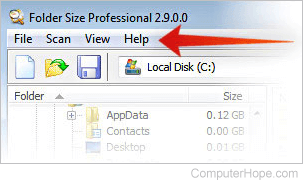Menu bar

A menu bar is a thin, horizontal bar containing the labels of menus in a GUI (graphical user interface). The menu bar provides the user with a place in a window to find program's essential functions. These functions include opening and closing files, editing text, and quitting the program. Although menu bars are usually present in most GUIs, they may differ depending on the operating system you're using.
The menu bar is often above other toolbars.
Microsoft Windows menu bars
In Microsoft Windows, the menu bar is beneath the title bar. The menu bar in Windows may be accessed via keyboard shortcuts. Pressing the Alt and the menu-specific hotkey (which appears as an underlined letter in the menu) activates that menu choice. Below is a diagram of a Windows file menu with a description of each part of the menu.

With Windows 8, Windows 10, and full-screen programs, the menu bar may be hidden to improve the appearance of the program. To show the menu bar move your mouse or finger to the top of the screen.
Apple OS X menu bars
The menu bar on a Mac is a thin bar found anchored to the top of the screen. Unlike Microsoft Windows menu bars, which appear in each window, menu bars in OS X always appear at the top of the screen. When you switch to another application, the menu bar changes accordingly.
The following is a diagram of a simple Mac menu bar and the functions of each menu item:
![]()
- By clicking the Apple logo in the left corner of the menu bar, you'll access the Apple menu.
- Adjust the Finder properties. To open Finder, click the Finder icon on the dock.
- The middle File, Edit, View, Go, Window, Help all interact with the Apple OS or program you're currently running if one is open.
- Next, the status menus display quick information about the sound, Wi-Fi, battery, time, etc.
- Finally, use Spotlight to find any files on your computer.
Why is the menu bar missing?
Not all programs use a file menu. For example, in new Office programs instead of a file menu it uses the Ribbon. Other programs may use a hamburger menu, kebab menu (e.g., Chrome), or meatballs menu (e.g., Edge) to access the programs features. For these programs, you'll need to use the alternative menu system.
Some programs may also hide the file menu to keep the interface clean. With these programs, press the Alt or F10 any time you want to open the file menu. Other programs may only show the menu when the mouse pointer is moved to the top of the screen or when scrolling up.
Apple terms, Contextual menu, GUI, Menu, Navigation bar, Operating system terms, Software terms, Title bar, Toolbar
